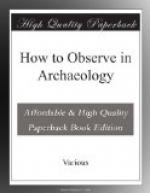Pottery is most difficult to pack safely. For large jars, mark the points of contact on the box, and nail on cushions of old cloth stuffed hard with straw, so as to pad the jar on all sides; make sure that it cannot twist about into a diagonal position off the pads. Long boxes, five or six feet, with three or four cross divisions, are best. Begin packing, say four pots with straw, at one end of the box, press up a cross board tight on them, and nail through the sides: then another batch likewise; about one inch thick of hard-pressed straw is needful at each contact. Twist straw into rough bands, and wind it round each pot. Fill up corners to prevent the bands shifting loose. Empty small tins make good stuffing for blank spaces. Old newspapers torn to bits and rolled into balls make good packing for pots and hold them firmly, but this method is dangerous if the packing becomes wetted. Pots should always be packed tight. Old sacking or cotton stuff may be tied on over the mouth of large pots, to prevent straw slipping in, and loosening the packing.
Bronzes and coins should not be cleaned in any way, till in a settled work place.
8. Forgeries and. Buying.
Most travellers wish to buy some things of interest, and in remote districts they may do good service in rescuing important objects which may be wanted in museums. Forgeries are ubiquitous, even in most obscure places in the hands of peasants, either supplied by dealers, or casually obtained, often in good faith. It is best to inquire of local collectors and museums as to the kinds of forgeries met with. The following notes are to show the novice how far he may go safely.
Bronze figures with a thick red patina, which scales off readily sometimes, or with thick green patina cracked, or hard green or brown patina, are safe. Thin green patina, or bare brown or black metal is dubious.
Papyri in roll, flexible though fragile, in known Greek or Egyptian writing, are fairly safe. Lumps stuck together, brown and scrappy, are made up.
Coins cannot be safely bought unless patinated, copper or silver. Only an expert can judge of gold or ’clean silver.
Jewellery of small size, as earrings and bracelets, is generally safe, if the age of the design is known. Modern wire is always drawn, ancient is irregular. Look for concretions of lime in the hollows, and for the dull face of old gold. If once cleaned there is little to distinguish old from modern gold.
Stone vases if turned are Roman or modern. The ancient irregularities should be studied from specimens.
Scarabs with nacreous or decomposed glaze in the hollows (as in the deep cuts at the side) are safe; also, if there are natural cracks by age, which would prevent modern cutting. There is a large variety of skilful forgeries.
Stone statuettes: a skilled forger may be paid up to 100 pounds for a figure to order. Only an expert can judge.




